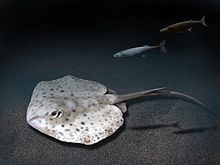Rhombodus is a prehistoric genus of ray belonging to the family Rhombodontidae.
| Rhombodus Temporal range: [1]
| |
|---|---|

| |
| Fossil tail spines of Rhombodus meridionalis from Khouribga (Morocco.) | |
| Scientific classification | |
| Kingdom: | |
| Phylum: | |
| Class: | |
| Order: | |
| Family: | |
| Genus: | Rhombodus Dames 1881[1]
|
Species within this genus lived from the Cretaceous period, Maastrichtian age to the Paleocene epoch, from 70.6 to 55.8 million years ago.[1]

Species
editSpecies within this genus include:[1]
- Rhombodus andriesi Noubhani and Cappetta 1994
- Rhombodus binkhorsti Dames, 1881 North America
- Rhombodus bondoni Arambourg 1952
- Rhombodus carentonensis Vullo 2005
- Rhombodus ibericus Kriwet et al. 2007
- Rhombodus laevis Cappetta and Case 1975
- Rhombodus meridionalis Arambourg 1952
- Rhombodus microdon Arambourg 1952
Description
editRhombodus species could reach a length of 75–100 centimetres (30–39 in).[3] This genus is known from its caudal spines and rhombic teeth, which are all that usually fossilises. These rhombic teeth are bilobate, with vertical wrinkles and a width of about 1.5 centimetres (0.59 in).[4]
Distribution
editFossils have been found in the sediments of Africa, Europe, Asia and the Americas.[1]
See also
editReferences
edit- ^ a b c d e Fossilworks
- ^ Cuny, Gilles; Martin, Jeremy E.; Sarr, Raphaël (2012-04-01). "A neoselachian shark fauna from the Late Cretaceous of Senegal". Cretaceous Research. 34: 107–115. doi:10.1016/j.cretres.2011.10.008. ISSN 0195-6671.
- ^ Cow Nosed Rays
- ^ Jim Bourdon Rhombodus - Extinct myliobatoid ray